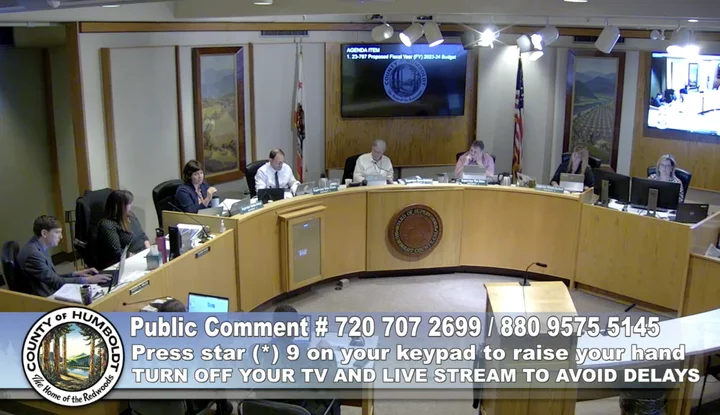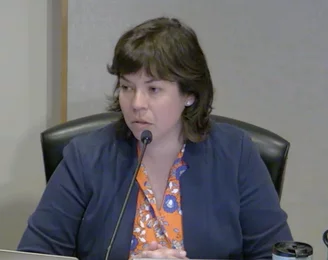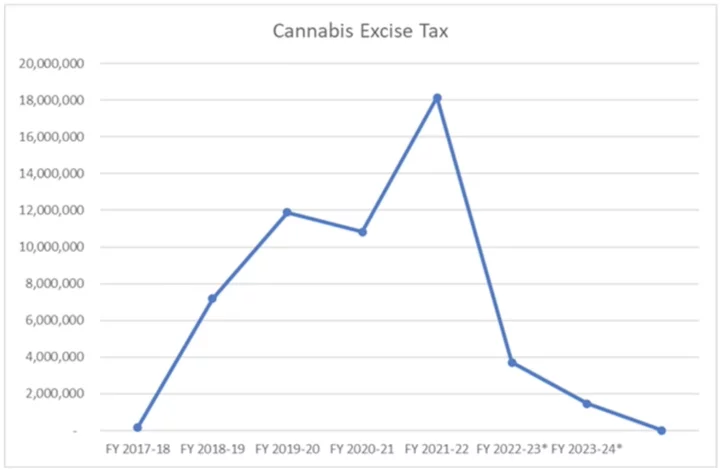Screenshot of Tuesday’s Humboldt County Board of Supervisors meeting.
Billboards! Some people love ‘em, some people hate ‘em! It turns out the Humboldt County Board of Supervisors is pretty split on the matter.
There’s been a recent surge in local municipalities taking action to ban or limit the construction of new billboards, off-premise signs and illuminated signs. Earlier this year, the City of Eureka adopted an ordinance to ban new digital billboards and signs across the city.
The Humboldt County Board of Supervisors considered a request from staff during Tuesday’s meeting to adopt a 45-day urgency ordinance that would place a temporary moratorium on permits for new billboards, off-premise signs and illuminated signs within the county’s jurisdiction.
County staff have been working on a draft ordinance to limit the construction of new billboards for several months. Planning and Building Director John Ford noted that it can take time – even years – to develop and adopt such an ordinance. A temporary moratorium could prevent potential developers from rushing to permit new billboards and digital signs while the draft ordinance is under review, he said.
“There’s a lot of experience in the state that when jurisdictions start proceeding down this path, [it] can sometimes trigger a bit of a stampede towards trying to get [their permits] in before the ordinances get established,” Fifth District Supervisor and Board Chair Steve Madrone reiterated. “This doesn’t actually eliminate anything that currently exists.”
First District Supervisor Rex Bohn asked if staff had seen a dramatic uptick in permit applications to build new billboards in Humboldt County. Ford said his department has “not seen any new applications for billboards” in the last year but noted that there is an illuminated sign on South Broadway that would be affected by the proposed regulations because it was constructed without permits.
“[It] seems like we worry about a lot of stuff that’s not going to happen and we’ve got a lot of stuff that is happening right now that, I think, is a lot more pressing,” Bohn said. “I don’t see a problem. … I know one business that was using [billboards] said 65 percent of his business came from that. So, I guess it might be as good a time as any to put a dagger in somebody’s business, but I don’t think that’s what we’re going to try to do. I’m probably not in favor of this one.”
Third District Supervisor Mike Wilson countered, noting that the City of Eureka received “numerous” permit applications to construct illuminated signs after the city announced that it was modifying its sign ordinance.
“There were numerous applications made and some of them were actually put through under the wire [even though] they didn’t conform with the regulation[s] as it came out the other end,” Wilson said. “A rush did happen. We see it and we can point to those in Eureka and we drive by them all the time. … If Eureka had done what we’re talking about today those wouldn’t be there.”
Wilson also pointed out the environmental impacts associated with digital billboards specifically, including impacts to nighttime wildlife and light pollution in neighborhoods that are adjacent to commercial zones.
Bohn noted that some businesses, including Shafer’s Ace Hardware on Harris Street, turn off their digital signs around 10 p.m. He added that he has “never gotten a residential complaint” about that sign and reiterated his doubts that the proposed regulations would spur an onslaught of businesses wanting to build new billboards.
“Anybody that brings anything in front of us to build or anything else, we want to have our hand in it and restrict it in as many ways as possible and make it unfeasible to happen,” he said. “But then we’ll talk about the shortage of tax dollars, business, housing and everything else. … I just can’t support this.”
Madrone reiterated that the temporary moratorium would not take away any existing billboards, but said it does prevent a big onslaught. “And if we don’t have a big onslaught, then it’s not a problem either way, right?”
Fourth District Supervisor Natalie Arroyo also highlighted the visual and environmental impacts associated with billboards, adding that “there is something to be said for the unique and beautiful character of this place.”
“The natural beauty [of Humboldt County] is a huge aspect to why people come to this place … and I don’t think we can overstate that,” she said. “That’s one of our biggest assets. My own personal buying habits aside – because I’m a millennial and I don’t care – I would so much rather not see a billboard. It just doesn’t do anything for me except seem obnoxious. … There are many ways to advertise these days and most patrons of businesses are utilizing other means to find out about businesses and to determine where to take their business.”
Giving staff time to research the subject further “is no problem in my book,” Arroyo added.
“This is not my first sign rodeo,” she said, referring to her time on the Eureka City Council. “I have learned from the past … that hemming and hawing and taking a long time to decide about something because there were some folks who had concerns ended up resulting in some of those exact outcomes that we didn’t want.”
Arroyo made a motion to approve staff’s recommendation and approve the temporary moratorium. Wilson seconded the motion.
Second District Supervisor Michelle Bushnell asked Ford if there were currently any applications in the queue to build new billboards. He said there were not.
“So, we could assume then that nobody’s ordered that machinery or whatever because they would have to do the permit first with all the specs and blah, blah, blah,” Bushnell suggested.
“There’s always an action and a reaction,” Ford said. “When jurisdictions put regulations out and people [see] that it’s going to regulate something that they may want to do, there’s a rush to go out and build them and ask for forgiveness or ask for permission and submit an application to get in ahead of the regulatory process.”
Ford added that the county is just about ready to issue the draft ordinance for public review. “That [process] will probably take a month to six weeks and then move to the [Humboldt County] Planning Commission for approval.”
After a bit of additional discussion, the board voted 3-2, with Bohn and Bushnell dissenting, to approve the temporary moratorium on new billboards. But because the item required a four-fifths vote for approval it did not pass. Staff informed the board that it would have to either modify the motion to reach a four-fifths vote or pass a motion affirming that the initial motion did not pass.
In most cases, the board would continue to deliberate until some level of consensus was reached among its members to provide a reportable action for the discussion at hand, said County Administrative Officer Elishia Hayes. “Affirming that the moratorium has not passed with a two-thirds vote will give the [Clerk of the Board] an action that can be recorded as it relates to this.”
Wilson made a motion to apply the temporary moratorium to the third, fourth and fifth districts, which Arroyo seconded, in an attempt to appease both sides. “I’m parsing here because it’s just, like, I want to protect my community,” Wilson said. “And that’s where I’m at. I feel it’s important.”
After a bit of confusion surrounding the procedure and protocols for the item, the board eventually voted 3-2, with Bohn and Bushnell dissenting once again, to affirm that the first motion did not pass, meaning the temporary ban on billboards did not go through.
Clear as mud, right?
Short-Term Rental Ordinance
The board discussed a similar moratorium that would temporarily ban new short-term rentals (Airbnb, Vrbo, etc.) in Humboldt County while staff circulates a draft ordinance that would regulate dwelling units that are rented to guests for 30 consecutive days or less.
“Commercial use of residential structures for short-term rental has led to speculation on homes which has exacerbated housing scarcity and inflated housing prices, and the new regulations seek to better balance the supply and demand for housing,” according to the staff report. “In other jurisdiction[s] that have adopted regulations for short-term rentals, consideration has been given to existing rentals even though operating in violation of the Zoning Ordinance. The moratorium would remove the incentive to claim a pre-existing status.”
While the exact number of short-term rentals in Humboldt County is unknown, Ford estimated that there are roughly 1,000 short-term rentals operating in the county, most of which are unpermitted.
Wilson spoke in favor of a temporary ban, noting that the influx of short-term rentals has hindered access to housing across the county and even caused renters to be evicted.
“Property owners are trying to rush to convert [housing] into short-term rentals because they see a potential cap coming,” he said. “For me, the crux of the issue [and] why I strongly support this moratorium … is so we don’t we don’t give incentive … for properties that have long-term renters into conversions because they may think it’s their last chance to do so.”
Bushnell asked Ford what would happen to existing short-term rentals if the temporary moratorium did not move ahead.
“Well, we do not proactively go out and search for short-term rentals,” Ford replied. “We are complaint-driven and, frankly, not a week goes by that we’re not dealing with a struggle with a short-term rental because the neighbors are complaining about it.”
Bushnell asked if there would be preference given to individuals who are already operating short-term rentals in the county. Ford said it wasn’t written in the draft ordinance as of yet but assumed there would probably be “a strong lobby to include that in the ordinance.”
Bushnell acknowledged the issues of housing inaccessibility in the “more urbanized areas” of the county but said rural communities are struggling to fill empty homes.
“In Southern Humboldt specifically, there are so many empty homes [and] apartments,” she said. “I don’t want to impose a moratorium on something that I feel some people are going to turn [to] … to try and save their homes … now that they’re empty. I’m struggling a little bit with it.”
The board spoke at length about the pros and cons of a temporary moratorium on short-term rentals, noting several times the anticipated impacts associated with increased enrollment at Cal Poly Humboldt, in addition to several other incoming developments around the Humboldt Bay region.
After quite a bit of discussion, the board eventually passed the temporary moratorium on short-term rentals in a 4-1 vote, with Bushnell dissenting. The item will appear before the planning commission for approval later this summer.
Proposed Budget for Fiscal Year 2023-24
Earlier in the meeting, the Board of Supervisors took its first look at the draft budget appropriations for the upcoming fiscal year and, unfortunately, it looks as though the county is in store for another year of financial distress.
Sales tax revenues have dropped considerably in the last year, cutting millions of dollars from the county’s projected income. With costs simultaneously rising due to inflation, higher employee salaries and more expensive benefits, the county is looking at a $17.7 million budget shortfall in fiscal year 2023-24.
“The total proposed budget or spending plan before your board is $578.5 5 million … [which] represents an increase of $7.2 million, or 1.3 percent more than the [2022-23] adopted budget,” Deputy CAO Jessica Maciel told the board. “The small increase is a combination of the efforts of departments to minimize expenditures while incorporating salary and benefit increases and the impacts of inflation and most expenditure categories.”
Staff are projecting $126.97 million in revenue for the general fund in 2023-24, a decrease of $26.2 million from the current fiscal year. Maciel largely attributed the decrease in revenue to the county’s decision to move the capital projects budget into a fund separate from the general fund, “as well as reductions in Measure Z expenditures and use of one-time [American Rescue Plan Act] ARPA funds for the jail medical contract.”
The general fund will utilize $35.9 million in other financing sources, Maciel said, including the use of that $17.7 million fund balance to present a balanced budget for the upcoming fiscal year.
The Board of Supervisors made strides toward fiscal sustainability in the current fiscal year by contributing $5 million to the county’s general reserves, Maciel said. While the proposed budget does not include a contribution to the general reserves, she urged the board to revisit the subject and see if additional funds are available during the mid-year budget review in February 2024.
Maciel briefly touched on the county’s history of delinquent transactions and fiscal turmoil, noting that fiscal year 2021-22 “has not officially closed.”
“The auditor-controller has worked diligently to catch up delinquent transactions and prior years’ financial reporting so that staff are better able to estimate year-end fund balances,” she said. “While staff are able to provide estimates, there is still a significant amount of work that needs to be completed.”
The bulk of the board’s discussion revolved around Measure Z, the county’s half-cent sales tax for public safety and essential services, which has helped to fund hundreds, perhaps thousands of programs and individual projects over the years. However, the last year has had a significant impact on the Measure Z fund due to a dramatic reduction in economic activity across the county.
Deputy CAO Sean Quincey said the county is expecting to bring in $12.67 million in Measure Z revenue for fiscal year 2023-24, $1.8 million less than staff’s estimate for the current fiscal year. Current expenditures are expected to exceed $12 million, leaving approximately $623,429 for discretionary spending.
“Your board, during the May 22 meeting, approved deallocating seven of 16 positions that were allocated last year,” Quincey said. “Some of the positions were already projected to be funded for only half of the year so the salary savings amounted to a little under $500,000. It should be noted that the deallocated positions are all vacant. Still, the county added nine positions to Measure Z within the last year, increasing pressure on Measure Z funding.”
Bohn also acknowledged the increasing pressure on the Measure Z fund. “A lot of these services, I mean, the ambulance service in the Willow Creek area has doubled in nine years,” he said. “Everybody’s requests have grown and I think it’s part of our job to kind of look at that stuff and[realize] everybody’s going to have to take a little bit of a hit on this … It’s just going to be painful as we do it.”
Revenue through Measure S, the county’s cannabis cultivation tax, has also dried up. Last November, in a last-ditch effort to provide relief to struggling cannabis farmers, the Board of Supervisors agreed to suspend the tax for two years, which brought in as much as $18 million annually.
“This has added to the significant decline in the county’s discretionary revenue budget,” Maciel said. “[Over] $14 million remains outstanding for taxes assessed prior to the board’s action in November [of 2022]. Staff will return later this year to discuss potential changes and seek direction on alternative approaches to this tax.”
Revenue generated by Measure S since 2017. | Screenshot
Speaking during public comment, Natalynne DeLapp, executive director of the Humboldt County Growers Alliance, thanked the board for choosing to suspend Measure S “because that gave a lifeline to cannabis farmers.”
“Things could have been worse if we didn’t look at that,” she said. “Unfortunately, as the nation, the state and the county are looking at a recession, cannabis is not the vital industry that it once was to be able to support this.”
Following public comment, Wilson made a motion to approve staff’s recommendation to approve the proposed budget appropriations for fiscal year 2023-24, which will be further subject to further discussion and potential modifications during a special meeting next week. Bushnell seconded the motion.
After a bit of additional discussion, the board passed staff’s recommendation to approve the proposed budget in a 5-0 vote.
The board will hold a public hearing on Monday, June 12, to make final changes to the draft budget. If everything goes according to plan, the budget will be adopted two weeks later on June 27.




CLICK TO MANAGE